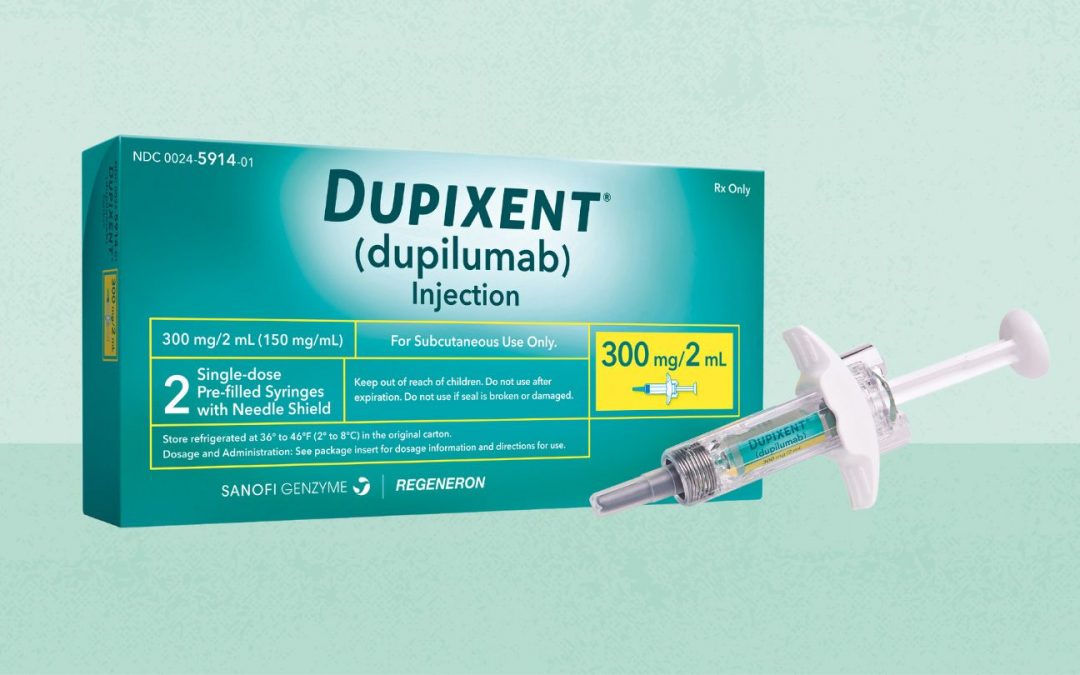Medical News Today Article By Paul Ian Cross, PhD on January 3, 2024.
In May 2022, the U.S. Food and Drug Administration granted approvalTrusted Source for Dupixent (dupilumab) for people ages 12 and older with eosinophilic esophagitis (EoE).
EoE is characterized by the presence of eosinophils, a specific type of white blood cell, in the esophageal tissue.
In adults and adolescents with EoE, common symptoms include difficulty swallowing, eating challenges, and food getting stuck in the esophagus.
Dupixent is a monoclonal antibody designed to inhibit a part of the inflammatory pathway.
Dr. Brooks Cash, a professor and chief of the division of Gastroenterology, Hepatology, and Nutrition at UTHealth Houston, told Medical News Today that “there are multiple different types of immune reactions that the body uses to protect itself depending on the target (for example viruses, parasites, bacteria, allergens).”
“In the case of EoE the type of immune response is called a type 2 immune response, which is the type of immune response directed toward allergens,” he explained.
“Other examples of this type of immune response include asthma, hives, allergic rhinitis, and certain food allergies,” Cash added.
“In the case of EoE, when the body is exposed to certain allergens, an immune cascade occurs that results in trafficking and accumulation of specific immune cells called eosinophils in the esophagus,” Cash pointed out.
“These cells contain molecules such as histamine that are released when the cells are activated and release of these molecules can cause additional inflammation, swelling, and edema and eventually an increase in connective tissue in the wall of the esophagus,” he added.
“This final process is known as fibrosis. The inflammation and fibrosis that occurs with EoE can cause symptoms of dysphagia, or food getting stuck in the esophagus,” Cash said.
This can lead to food impaction, especially with foods such as meats which may require removal with upper endoscopy and are considered emergencies due to the risk of esophageal rupture. EoE can affect adults as well as children and may be accompanied by other allergic symptoms such as hives and allergic rhinitis.
Dr. Brooks Cash
Cash noted that “while the most common cause of dysphagia is complications from gastroesophageal reflux disease (aka GERD), EoE is an important cause of dysphagia to consider in patients with dysphagia, especially if they do not suffer from chronic GERD symptoms or heartburn or regurgitation.”
The clinical trial looking at the efficacy and safety of Dupixent
The efficacy and safety of Dupixent for EoE were evaluated in a randomized, controlled, double-blind clinical trial, conducted at multiple centers.
In the study, researchers conducted two separate 24-week treatment periods, Part A and Part B. In Part A, participants were given either a placebo or a 300-milligram dose of Dupixent weekly. In Part B, participants were given a 300-milligram dose of Dupixent weekly, a 300-milligram does of Dupixent every two weeks, or a placebo once weekly.
Researchers measured the reduction in eosinophil levels in the esophagus (throat) at week 24, which is determined by looking at tissue samples under a microscope, and the change in a questionnaire called the Dysphagia Symptom Questionnaire (DSQ) score from the beginning to the end of the 24 weeks.
The DSQ helps assess how difficult it is for people to swallow, with higher scores indicating more severe symptoms.
In Part A, 60% of the participants who received Dupixent achieved the desired reduction in eosinophil levels, compared to only 5% of those who got a placebo.
Participants in Part A who received Dupixent also reported an average improvement of 22 points in their DSQ score, while those on placebo reported a 10-point improvement.
In Part B, target eosinophil reduction was achieved in 59% of participants on weekly Dupixent and 60% of participants on Dupixent every two weeks, compared to just 6% of those on placebo.
Participants in Part B who received Dupixent weekly reported an average improvement of 24 points in their DSQ score, while those receiving it every two seeks and those on placebo reported a 14-point improvement.
Overall, researchers said, these results suggest that Dupixent can be effective in reducing symptoms and improving swallowing difficulties in patients with EoE.
Challenges for healthcare providers when treating EoE
Cash highlighted that the main challenge when treating EoE is raising awareness, gaining access to diagnostic tests and finding effective therapies for EoE.
Diagnosis requires upper endoscopy and biopsies. Initial treatments include food elimination diets, acid suppression meds and swallowed steroids, although none are FDA-approved and not universally effective.
Dupixent is therefore a promising option, but its role, cost, and insurance coverage are still uncertain, which can be a limitation, especially for uninsured people.
Dr. Zeeshan Afzal, a health content advisor at Welzo who was not involved in the research, told Medical News Today that “diagnosing EoE can be challenging as its symptoms can overlap with other esophageal disorders. It often requires multiple tests, including endoscopy with biopsy, to confirm the diagnosis.”
“Managing EoE typically involves dietary modifications and medication to control symptoms and inflammation,” Afzal explained.
“Before the approval of Dupixent, there were limited treatment options for EoE. Patients might have had to rely on corticosteroids or dietary restrictions, which may not provide long-term relief,” he added.
Implications for improved patient outcomes
This new medication is a great advance in the care of patients with EoE and it’s exciting to see medications directed toward the pathophysiologic basis for a condition come to market based on good clinical research showing clinical improvement in symptoms as well as the inflammatory changes in the esophagus.
Dr. Brooks Cash
However, “we still need to determine where this medication fits, right now it is generally used in patients who did not have a complete or durable response to other therapies,” Cash pointed out.
“We also need to determine how long patients should be treated with this medication and when and how we should consider decreasing or stopping this medication in patients who respond,” he added.
Afzal noted that the new medication will allow people with EoE to experience symptom relief, “making it easier to eat and swallow.”
This can lead to an improved quality of life for those living with the condition.
However, “access to Dupixent may be a concern for some patients due to its cost, but the approval may prompt discussions around insurance coverage and affordability.”
In conclusion, Afzal said that “healthcare providers will need to educate patients about the benefits, risks and proper use of Dupixent, as well as monitor them for potential side effects.”
Read full article here.

